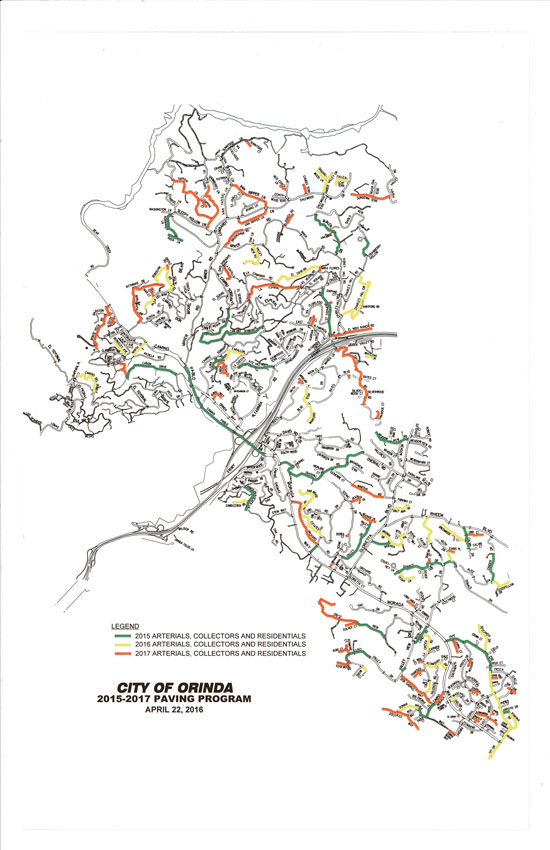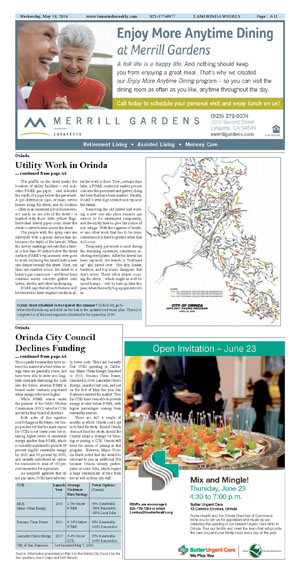|
|
Published May 18th, 2016
|
In Orinda, Utility Work is the Harbinger of Repaving Season
|
|
| By Victor Ryerson |
 |
| A PG&E welder cuts a new steel lateral for installation. Photo Victor Ryerson |
This spring's spectacular show of flowers is not the only sign that summer is coming. If you live on an Orinda street that is slated to be repaved this year under the city's road repair plan, you may have stepped out of your home recently to find your street covered with colorful graffiti. It's all legal - the first step in preparing the street for the onslaught of backhoes, skip loaders, trucks and other heavy equipment later this year.
 "I thought they were putting in a speed bump [in front of my house]," mused one Ivy Drive resident as she looked at the lines painted across the street and onto her lot. "Shows how well informed I am."
"I thought they were putting in a speed bump [in front of my house]," mused one Ivy Drive resident as she looked at the lines painted across the street and onto her lot. "Shows how well informed I am."
 The fact is that, although some effort has been made to let residents know what is going on, public outreach by the city and utility companies could be better. Contractors have quietly shown up in front of homes, spray-painting strange hieroglyphics on the pavement, and little yellow flags have popped up across front yards and well into people's lots, fueling speculation and concern by homeowners. Machinery has followed, and a number of owners were surprised last month when a backhoe started chomping into their curbs and yards, preceded only by a knock on the door by the harried Pacific Gas and Electric Company foreman in charge of the work. Alerted to the notice problem, the utility finally distributed flyers in door-hangers to local area residents after the work was underway. Still, the process remains a mystery to many.
The fact is that, although some effort has been made to let residents know what is going on, public outreach by the city and utility companies could be better. Contractors have quietly shown up in front of homes, spray-painting strange hieroglyphics on the pavement, and little yellow flags have popped up across front yards and well into people's lots, fueling speculation and concern by homeowners. Machinery has followed, and a number of owners were surprised last month when a backhoe started chomping into their curbs and yards, preceded only by a knock on the door by the harried Pacific Gas and Electric Company foreman in charge of the work. Alerted to the notice problem, the utility finally distributed flyers in door-hangers to local area residents after the work was underway. Still, the process remains a mystery to many.
 What is happening is the result of the city learning from experience about coordinating utility work with the repaving. "It's not easy," said Orinda Citizens Oversight and Infrastructure Commission member Richard Nelson at a recent Orinda Association informational meeting. The city has been learning from last season's repaving experience. The work is designed to reduce the likelihood that the paving work will damage gas distribution lines and other utility facilities that serve adjacent homes, and prevent the need to cut into the newly paved street to make subsequent repairs. In the long run, it is an effort well worth making.
What is happening is the result of the city learning from experience about coordinating utility work with the repaving. "It's not easy," said Orinda Citizens Oversight and Infrastructure Commission member Richard Nelson at a recent Orinda Association informational meeting. The city has been learning from last season's repaving experience. The work is designed to reduce the likelihood that the paving work will damage gas distribution lines and other utility facilities that serve adjacent homes, and prevent the need to cut into the newly paved street to make subsequent repairs. In the long run, it is an effort well worth making.
 Most of the preparatory work is being done by PG&E. The process takes time, and is being accomplished in stages as crews are rotated to other area projects, including Moraga's infamous sinkhole. Pipe welders are in particularly short supply.
Most of the preparatory work is being done by PG&E. The process takes time, and is being accomplished in stages as crews are rotated to other area projects, including Moraga's infamous sinkhole. Pipe welders are in particularly short supply.
 The graffiti on the street marks the location of utility facilities - red indicates PG&E gas pipes - and indicates the depth of a pipe below the pavement. A gas distribution pipe, or main, serves homes along the street, and its location - often in an easement across homeowners' yards on one side of the street - is marked with those little yellow flags. Individual lateral pipes cross under the street to serve homes across the street.
The graffiti on the street marks the location of utility facilities - red indicates PG&E gas pipes - and indicates the depth of a pipe below the pavement. A gas distribution pipe, or main, serves homes along the street, and its location - often in an easement across homeowners' yards on one side of the street - is marked with those little yellow flags. Individual lateral pipes cross under the street to serve homes across the street.
 The people with the spray cans are surveyors with a special device that determines the depth of the laterals. When the survey markings indicate that a lateral is less than 30 inches below the street surface, PG&E's replacement crew goes to work, replacing the lateral with a new one deeper beneath the street. First, cut lines are marked across the street to a home's gas connection - and those lines continue across concrete gutters onto lawns, shrubs, and other landscaping.
The people with the spray cans are surveyors with a special device that determines the depth of the laterals. When the survey markings indicate that a lateral is less than 30 inches below the street surface, PG&E's replacement crew goes to work, replacing the lateral with a new one deeper beneath the street. First, cut lines are marked across the street to a home's gas connection - and those lines continue across concrete gutters onto lawns, shrubs, and other landscaping.
 PG&E says that all such features will be restored to their original condition after the work is done. Then, perhaps days later, a PG&E contractor makes precise cuts into the pavement and gutters along the lines that have been marked. Finally, PG&E's crew digs a trench and replaces the lateral.
PG&E says that all such features will be restored to their original condition after the work is done. Then, perhaps days later, a PG&E contractor makes precise cuts into the pavement and gutters along the lines that have been marked. Finally, PG&E's crew digs a trench and replaces the lateral.
 Removing the old lateral and welding a new one into place requires gas service to be interrupted temporarily, and the utility tries to give fair notice of any outage. With the vagaries of weather and other work that has to be done, sometimes it is hard to predict when that will occur.
Removing the old lateral and welding a new one into place requires gas service to be interrupted temporarily, and the utility tries to give fair notice of any outage. With the vagaries of weather and other work that has to be done, sometimes it is hard to predict when that will occur.
 Temporary pavement is used during the trenching operation, sometimes including steel plates. After the lateral has been replaced, the trench is "buttoned up" and paved over. The skip loader, backhoe, and big trucks disappear. But don't worry. Those zebra stripes crossing the street - which might as well be speed bumps - will be torn up later this year, when the really big equipment rolls in.
Temporary pavement is used during the trenching operation, sometimes including steel plates. After the lateral has been replaced, the trench is "buttoned up" and paved over. The skip loader, backhoe, and big trucks disappear. But don't worry. Those zebra stripes crossing the street - which might as well be speed bumps - will be torn up later this year, when the really big equipment rolls in.
 Is your street scheduled to be repaved this summer? To find out, go to
Is your street scheduled to be repaved this summer? To find out, go to
 www.cityoforinda.org and click on the link to the updated road repair plan. There is a complete list of the road segments scheduled to be repaved in 2016.
www.cityoforinda.org and click on the link to the updated road repair plan. There is a complete list of the road segments scheduled to be repaved in 2016.

|
 |
| |
|
|
|
|
|
|
| |
|
|
|
|





